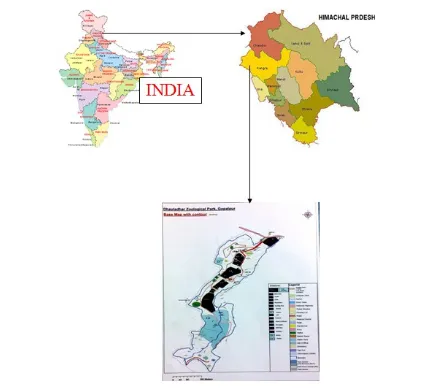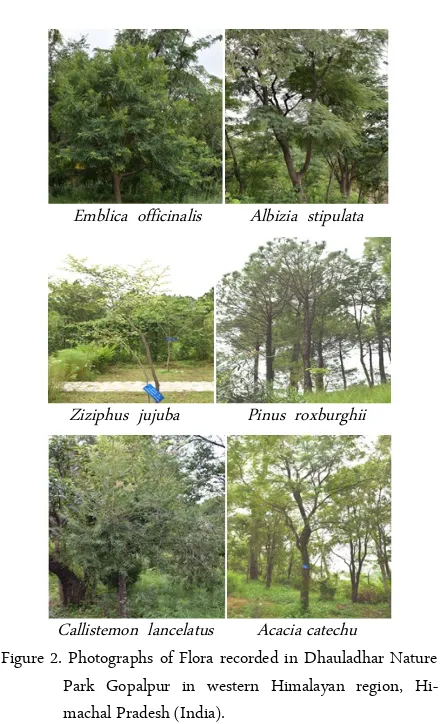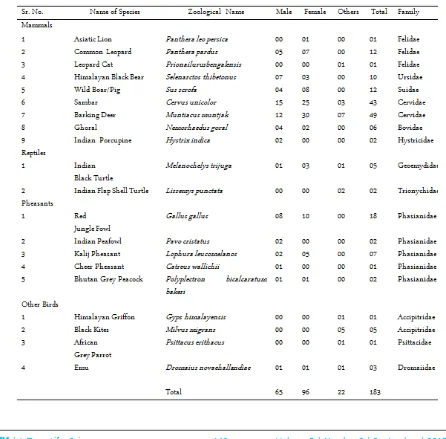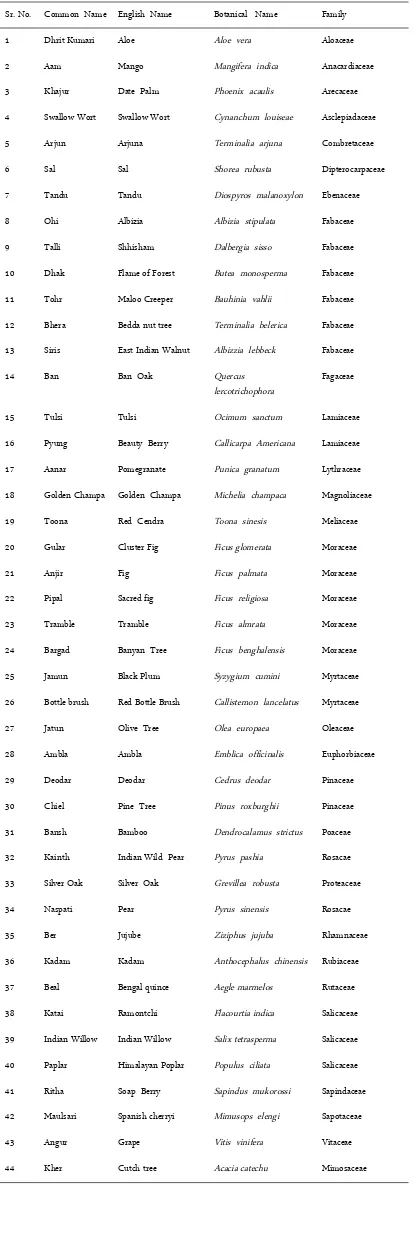VOL. 5, NO. 3, pp. 147-151, September, 2015
A Field Survey to Investigate The Flora and Fauna of Dhauladhar Nature Park
in North-Western Himalayan Region of India
Neeraj Kumar Sharma1*
1
Zoology, Govt. Degree College Nagrota Bagwan, Himachal Pradesh-176047
ABSTRACT
Taxonomic studies on wildlife biodiversity has always been very fascinating along with great purpose of providing valuable information of their present status with regard to species number and future course of action required for their conservation. A study regarding survey of flora and fauna was carried out at Dhauladhar Na -ture’s Park of Gopalpur in district Kangra of Himachal Pradesh during the month of April, 2015. The present study has revealed the presence of 9 mammals, 2 reptilians, 5 pheasants and 4 other birds belonging to 12 families along with 44 plants species belonging to 28 families. Further, it is suggested that provisions for Himalayan snakes and butterflies, the other two are very important Himalayan fauna which could be created as soon as possible so that nature’s park can fulfill its true purpose of conservation of Himalayan wild animals in real sense.
Keywords: fauna, flora, Nature Park, wild life biodiversity
The idea of protection and preservation of wildlife has been an integral part of our religion and culture ethos since the ancient times. Our Vedic hymns and mythology is in full praise of animals and depicting many of them as God. Wildlife in layman’s language refers to magnificent animals and birds in their natural habitats such as jungles, deserts, grasslands etc. How-ever, scientifically it includes both animals and plants in their wilderness. Neutral diversity theories predict that species number and immigration rates are suffi-cient to predict animal and plant community abun-dance distributions [1-3].
As far as the northwestern Himalayan flora and fauna is concerned it is mainly affected by climatic conditions and altitude. Which is mainly responsible for wide spectrum of species, however in past few decade factors like haunting [4], forest fire, destruction of habitats due to development works, deforestation, pollution and cleanliness, introduction of exotic species, construction of new highways, physical alter-ation of environment, lack of environment sensitivity and official laxity have been mainly responsible to be a great threat to wild life. Few authors have dared to
document the declines in the number of components of biodiversity [5-7].
Therefore, the continuous rising in the number of endangered species list have necessitated in present time to speed up our efforts for the protection and management of wild life on a much larger scale and faster rate. A number of initiatives have been taken up in this direction for the benefit of wildlife. The Indian Board for Wildlife (IBWL) has been established as far INTRODUCTION
*Corresponding author: Neeraj Kumar Sharma
Zoology, Govt. Degree College Nagrota Bagwan, Himachal Pradesh-176047, India
E-mail: Sharma.neeraj.neeraj03@gmail.com
as in the year 1952 to manage and look after the country’s wildlife. Since 1955, wildlife week is observed every year to educate people about the importance and need for the protection of wildlife biodiversity. Trade in rare and endangered species has been banned under the wildlife (Protection) Act, 1972. National Parks and Sanctuaries have been setup in different corner of the country under this act for the preservation of wildlife.
Falling in this line the Govt. of Himachal Pradesh has also setup on 23th
April, 1992 a nature park in the lap of Dhauladhar range of Himalaya named as “Dhauladhar Nature Park” in Gopalpur (Distt.Kangra) with the aim to sensitize and create awareness among public, rescue and conserve wild animals and to pro-vide opportunity for research. With regards to research studies on biodiversity of Dhauladhar Nature’s park is concerned, a beginning has been made by conducting study on birds biodiversity [8]. Therefore, more scien-tific studies are required so to have a deep insight to better understand the biodiversity of this nature’s park.
Study Area
Dhauladhar Nature Park is located in the mid-hills
of the Shivalik ranges of the Himalayas. The Park falls under wild life division of Hamirpur in Himachal Pradesh. Dhauladhar Nature Park is situated at 310
42’ North Latitude and 760
43’ East Longitude, having an altitude varying from 1235 to 1300 m of msl in the mid-hill of the northwestern region of Himalayas. It is located at a place known as Gopalpur which is at about 25 km from Kangra town, about 20 km from district headquarter Dharamshala, 13 km from Palampur and 6 km. from famous Chamunda Devi temple in District Kangra of Himachal Pradesh. The study area has been spread over in a land of about 12.5 hectares (Figure 1).
In order to know the flora and fauna of the Dhauladhar Nature Park, the undergraduate students in their 4th
semester in Zoology (Major) of Govt. De-gree College Nagrota Bagwan (Himachal Pradesh) participated in the survey under discussion. The whole area of Dhauladhar Nature Park was divided into 2 sections and a total of 25 students participated in this exercise. The fauna was recorded in toto, while flora of the nature’s park was recorded following the Random sampling technique. Further, the flora and fauna present in the Nature’s Park were identified with the help of relevant reference and text books. Similar methodology has also been followed while studying the bird’s biodiversity of this nature’s park [8]. The present
JTLS | J. Trop. Life. Science 148 Volume 5 | Number 3 | September | 2015
MATERIALS AND METHODS
Emblica officinalis Albizia stipulata
Ziziphus jujuba Pinus roxburghii
Callistemon lancelatus Acacia catechu
Figure 2. Photographs of Flora recorded in Dhauladhar Nature Park Gopalpur in western Himalayan region, Hi-machal Pradesh (India).
Panthera pardus
Selenarctos thibetonus Muntiacus muntjak
Pavo cristatus Sus scrofa
survey was carried out in the month of April, 2015.
During the course of investigation 9 mammals viz., Asiatic lion (Panthera leo persica), common leopard (Panthera pardus), leopard cat (Prionailurus bengalen-sis), Ghoral (Nemorhaedus goral), Barking deer (Muntiacus muntjak), Sambar (Cervus unicolor), Hi-malayan black bear (Selenarctos thibetonus), Indian Procupine (Hystrix indica), Wild boar (Sus scrofa); 02 Reptiles viz., Indian black turtle (Melanochelys trijuga) and Indian flap shell turtle (Lissemys punctata); 05 Pheasants viz., Red jungle fowl (Gallus gallus), Indian peafowl (Pavo cristatus), Kalij pheasant (Lophura leu-comelanos), Cheer pheasant (Catreus wallichii) and
Bhutan grey peacock (Polyplectron bicalcaratum bak-eri) and 04 Other Birds viz., Himalayan griffon (Gyps himalayensis), Black kites (Milvus migrans), African grey parrot (Psittacus erithacus) and Emu (Dromaius novaehallandiae) were found to have been kept in spe-cial enclosures made for these animals (Table 1 and Figure 3).
Birds are considered as an indicator of the good condition of the natural environment [9]. Also, a birds survey conducted during July, 2011 have revealed that 89 species of birds (probably in openness of nature’s park) have been present in this park and 49 out of these were of special concerns under wild life protec-tion Act [8]. Further studies are required to find out that how many types of Himalayan butterflies like RESULTS AND DISCUSSION
Junonia almanac, Torucus nara, Caprona alida, Ixias marianne, Danaus genutia, Moduza procris, Leptotes plinius, Catopsilia pyranthe, Danaus genutia, Euthalia nais, Lycaena phlaeas, Polyura athamas, Actolepis puspa, Vanessa cardui, Phalanta athamas, Dichorrha-gia nesimachus, Kallima inachus, Neptis hylas, Paran-tica sita, Papilio demolues etc. have made this park as their home. Provisions should also be made in the park for keeping of Himalayan snakes like Asian cobra (Naja oxina), Russell’s viper (Daboia russelli), Com-mon krait (Bungarus caeruleus), Saw scaled viper (Echis carinatus), Spectacled cobra (Naja naja), Himalayan pit viper (Gloydius himalaynus), Hi-malayan mountain keelback (Amphiesma platyceps), Common cat snake (Boiga trigonata) etc.
Plant relative abundances typically vary greatly among species in a community [3, 10-12]. The plants species in nature’s park were represented by family Aloaceae [Aloe], Anacardiaceae [Mango], Arecaceae [Date palm], Asclepiadaceae [Swallow Wort], Combre-taceae [Arjuna], Dipterocarpaceae [Sal], Ebenaceae [Tandu], Fabaceae [Albizia, Shhesham], Fagaceae [Ban oak], Lamiaceae [Tulsi, Beauty Berry], Lythraceae [Pomegranate], Magnoliaceae [Golden Champa], Meli-aceae [Red Cendra], MorMeli-aceae [Cluster fig, Fig], Myr-taceae [Black plum and Red bottle brush], Oleaceae [Olive tree], Euphorbiaceae [Ambla], Pinaceae [Deodar and Pine tree], Poaceae [Bamboo], Rosacae [Indian wild pear], Proteaceae [Silver oak], Rhamnaceae [Ju-jube, Pear], Rubiaceae [Kadam], Rutaceae [Beal], Sali-caceae [Indian willow, Poplar], Sapindaceae [Soap berry], Sapotaceae [Maulsari], Vitaceae [Grape] and Mimosaceae [Kher] (Table 2 and Figure 2).
In pristine time there was no dearth of natural re-sources, therefore man never felt like using these in a judicious manner. With the rapid growth of develop-ment during the last few centuries, there has been a lot of pressure on natural recourses including wildlife bio-diversity. Moreover irrational use of these recourses, have further taken the situation to blinking point. If corrected measurers are not taken stringently right now, we will not be able to return this earth in the same manner in which we have inherited it from our forefathers. Therefore, studies on wildlife biodiversity become altogether more important and relevant to know our present status and progress in conservational efforts before it being lost forever. Also, it appears from present survey that Dhauladhar Nature’s Park is play-ing a very important role in sensitizplay-ing and creatplay-ing
JTLS | J. Trop. Life. Science 150 Volume 5 | Number 3 | September | 2015
CONCLUSIONS
Table 2. List of flora recorded at Dhauladhar Nature Park Gopalpur in northwestern Himalayan region, Hi-machal Pradesh
Sr. No. Common Name English Name Botanical Name Family 1 Dhrit Kumari Aloe Aloe vera Aloaceae 2 Aam Mango Mangifera indica Anacardiaceae 3 Khajur Date Palm Phoenix acaulis Arecaceae 4 Swallow Wort Swallow Wort Cynanchum louiseae Asclepiadaceae 5 Arjun Arjuna Terminalia arjuna Combretaceae 6 Sal Sal Shorea rubusta Dipterocarpaceae 7 Tandu Tandu Diospyros malanoxylon Ebenaceae 8 Ohi Albizia Albizia stipulata Fabaceae 9 Talli Shhisham Dalbergia sisso Fabaceae 10 Dhak Flame of Forest Butea monosperma Fabaceae 11 Tohr Maloo Creeper Bauhinia vahlii Fabaceae 12 Bhera Bedda nut tree Terminalia belerica Fabaceae 13 Siris East Indian Walnut Albizzia lebbeck Fabaceae 14 Ban Ban Oak Quercus
lercotrichophora
Fagaceae
awareness among public, rescue and conservation of wild animals and by providing opportunity for re-search. Moreover, it has a lot of potential for further improvement as it could definitely play a very impor-tant role during the coming periods in conservation of some of the rare Himalayan species.
The author is highly thankful to Divisional Forest Officer, Wildlife Division Hamirpur, Distrcit Hamir-pur Himachal Pradesh and Range Forest Officer, Dhauladhar Nature’s Park Gopalpur District Kangra Himachal Pradesh for providing valuable information.
1. Caswell H (1976) Community structure: a neutral model
analysis. Ecol Mon 46: 327–354.
2. Bell G (2000) The distribution of abundance in neutral
communities. Am Nat 155: 606–617.
3. Hubbel SP (2001) The unified neutral theory of
biodi-versity and biogeography. Princeton Univ. Press.
4. Diamond J (1989) Overview of recent extinctions,
Con-servation for the twenty-first century. 1989: 37-41.
5. Pimm, Stuart L, Gareth J, Russell, John LG, Thomas MB
(1955) The future of biodiversity. Science-AAAS-Weekly Paper Edition 269(5222): 347-349.
6. Sala OE, Chapin FS, Juan JA, Eric B, Janine B, Rodolfo D,
Elisa-beth H (2000) Global biodiversity scenarios for the year 2100. Science. 287(5459): 1770-1774.
7. Vitousek PM, Harold AM, Jane L, Jerry MM (1997)
Human domination of Earth's ecosystems. Science. 277(5325): 494-499.
8. Chandel S, Kumar V, Sharma BP, Patiyal R (2014) Bird
Diversity of Dhauladhar Nature Park-Gopalpur, District Kangra, Himachal Pradesh. Asian Journal of Conservation Biology. 3(2014): 68–74.
9. Anil MNV, Kumari K, Watel SR (2014) Loss of
Biodiversity and Conservation Strategies: An Outlook of Indian Scenario. Asian Journal of Conservation Biology 3(2014): 105–114.
10. Grime JP (1998) Benefits of plant diversity to ecosystems: immediate, filter and founder effects. J. Ecol 1998(86): 902–910.
11. Magurran AE (2004) Measuring biological diversity. Blackwell Publishing, Oxford, U.K.
12. Wilsey BJ, Polley HW (2004) Realistically low species evenness does not alter grassland species richness produc-tivity relationships. Ecology 2004(85): 2693–2701.
ACKNOWLEDGMENT



